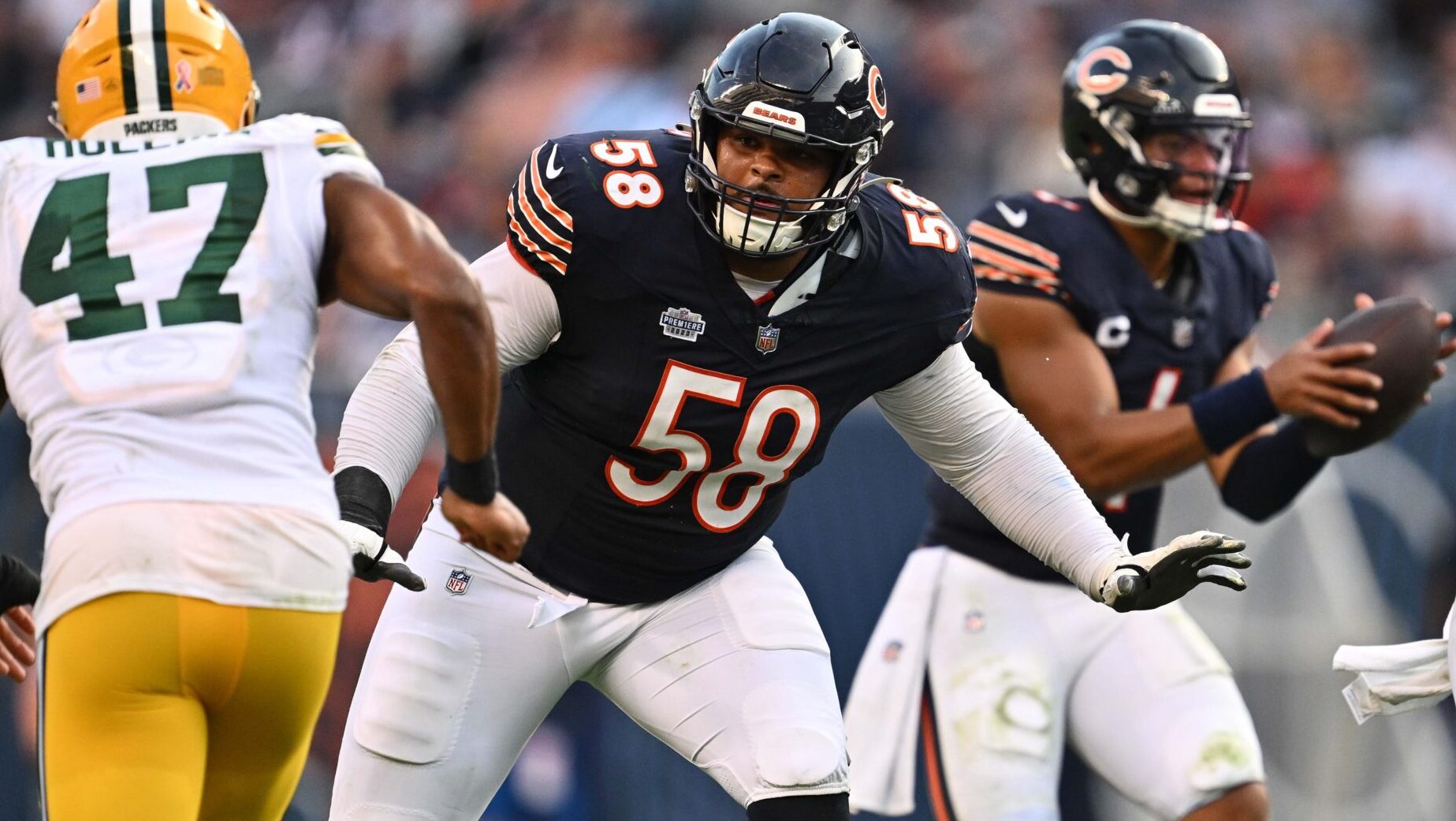Analysis
2/18/22
7 min read
Do Rushing Yards After Contact Translate to Wins?

In the NFL, running backs have varying physiques with diverse rushing styles. There are players like J.J. Taylor, listed at 5-6 and 185 pounds. Contrast that with someone like Derrick Henry, who checks in at 6-3 and 247 pounds, and the idea that these players can differ significantly is clearly illustrated. Although there is no one-size-fits-all formula for height and weight that is indicative of certain characteristics, there are overall trends.
Often, the larger rushers end up being stronger runners. The objective while running the football is to gain as many yards as possible before being tackled, so larger players that can break tackles are valuable in achieving this goal. To look at which teams fit this description the best, let’s take a look at how they stack up for rushing yards after contact.
The plot above compares how many yards per rush came after contact for teams and how many total yards were gained per rush, all of which came from the 2021 regular season. Teams with the most yards after contact per run included the Browns, Colts, and 49ers, while the teams with the fewest yards after contact per run were the Chiefs, Dolphins, and Cardinals. Let’s delve into why this was the case for each team.
Most Yards After Contact per Run
Cleveland Browns
Averaging over 3.5 yards after contact per run, the Browns had one of the best rushing attacks in football this past year. Cleveland ranked second in yards per carry and led the NFL in runs of at least ten yards. The Browns were also one forced missed tackle away from the league lead. Starting back Nick Chubb led this effort, gaining a whopping 4.2 yards per carry after contact; he ranked second in yards per carry after contact among all players with at least 60 rushes.
Chubb finished with 25 runs that picked up at least ten yards after contact, which led the NFL. Also, ranking in the top ten for yards after contact per run of rushers with 60 carries were Kareem Hunt and D’Ernest Johnson, furthering why Cleveland led the league in yards after contact per run.
Indianapolis Colts
Indianapolis was second this season in yards after contact per run, trailing only the Browns. However, the Colts outpaced Cleveland in total yards per carry, leading the NFL in this statistic. The team’s leading rusher was Jonathan Taylor, who finished second in Offensive Player of the Year voting. Taylor had the most runs of at least ten yards with 50, which was nine more than the next player. Also leading the NFL in total rush yards after contact by over 300 yards, the former Wisconsin Badger was a dominant force this season. This year, Taylor had the third-most yards after contact per run among players with over 70 carries.
San Francisco 49ers
San Francisco placed third in yards after contact per run as well as total rush yards after contact in 2021. Led by rookie sixth-round selection Elijah Mitchell, the 49ers had the highest positive residual in the plot above. Although the team didn’t finish in the top half for yards per carry, the ability to fight through contact this season was impressive. Mitchell’s 3.7 yards after contact per run was top-12 among players with at least 25 rush attempts, marvelous in its own right, but he wasn’t the most spectacular on his team in this regard.
Deebo Samuel took this award, leading the league in missed tackles forced per rush at over one missed tackle every three rushes. The versatile athlete was incredibly difficult to bring down in open space, and San Francisco wisely got him more involved in the run game this year.
Least Yards After Contact per Run
Kansas City Chiefs
Kansas City ended the regular season seventh in yards per carry at more than 4.5 yards, but the Chiefs were last in the NFL in yards after contact per run. Their leading rushers Clyde Edwards-Helaire and Darrel Williams played a part in this, posting just 2.4 and 2.2 yards after contact per run, respectively. The Chiefs forced only 33 missed tackles on rushes all season, which was 14 fewer than the next lowest team.
Another reason why Kansas City struggled in gaining yards after contact as a team is that their third-leading rusher was quarterback Patrick Mahomes. The signal-caller had just two missed tackles forced all season, good for an average of 0.03 per rush. Although unsurprising, teams with quarterbacks who run more often will typically have lower average yards after contact per run, as Mahomes had just 1.7 yards after contact per rush.
Miami Dolphins
The leading rusher for Miami in 2021 was Myles Gaskin, heading the charge for one of the poorest rushing attacks in the NFL. Finishing third-worst in both rush yards after contact and total rushing yards, the Dolphins struggled to run the football. Gaskin finished with just 2.2 yards after contact per run as the team’s leading rusher, but his backups weren’t much better. Duke Johnson Jr. was the best on the team in this category, but even he just finished with 3.3 yards after contact per run.
Salvon Ahmed racked up only 2.8 yards after contact per run, some of this coming since he forced just 0.07 missed tackles per rush. Tua Tagovailoa, like Patrick Mahomes, also brought his team’s yards after contact average down. His 1.6 yards after contact per run was the lowest among Dolphins with at least 20 carries this year.
Arizona Cardinals
Arizona had a decent rushing season overall, finishing in the top-11 in both rushing yards and rushing first downs. However, the Cardinals were poor in picking up yards after contact, gaining just 2.4 yards after contact per run. Their two leading rushers, James Conner and Chase Edmonds, each finished with about 2.8 yards after contact per run. This hurt Arizona’s average, but the largest hit came from Kyler Murray.
The quarterback ran the ball 88 times in the 2021 regular season, and he averaged just 0.9 yards after contact per run. Like the Chiefs and Dolphins, having their quarterbacks run more often hurt their yards after contact numbers. Although Conner and Chase put up yards after contact per run numbers near the league average for teams this season, Murray carried the ball on over 17% of Arizona’s runs, bringing the Cardinals’ yards after contact per run figure down.
Conclusion
After taking a look at the yards after contact per run numbers for the three teams leading the NFL and at the bottom, there are a few takeaways. First, teams that excel in the run game after contact have superior overall yards per carry numbers, on average. This can also be seen as the trend line in the graph has a positive relationship, a concept that, on average, translates to a loose correlation. This was seen as the Browns and Colts both ranked in the top-two in yards after contact per run, and the duo also finished as the top two teams in overall yards per carry.
Another concept that makes sense is that teams whose quarterbacks run more often will end with fewer yards after contact per run. This can be explained because signal-callers are usually told to slide when a defender is in position to make a tackle to avoid injury. Skill position players, such as running backs, wide receivers, and tight ends, are the ones who typically are best in totaling yards after contact instead, and few quarterbacks are above average in this statistic. The best player listed as a quarterback by PFF for yards after contact per run this year was Taysom Hill, who sometimes lined up as a wide receiver, running back, tight end, and even played on special teams.
Lastly, this statistic does not translate to winning. The Super Bowl Champion Los Angeles Rams finished 29th in yards after contact per run, yet the statistic-leading Browns didn't even finish above .500. This study simply illustrates the different running styles each NFL team has, and this shouldn’t be extrapolated further.
All statistics provided by PFF via TruMedia, unless otherwise noted















